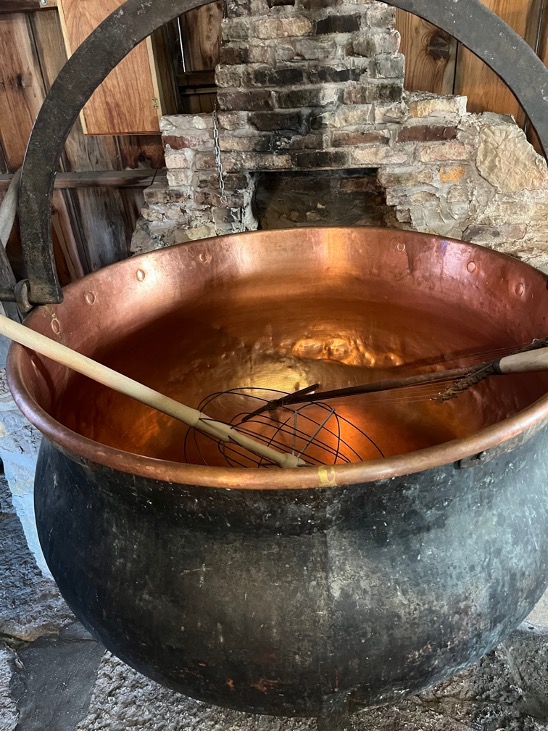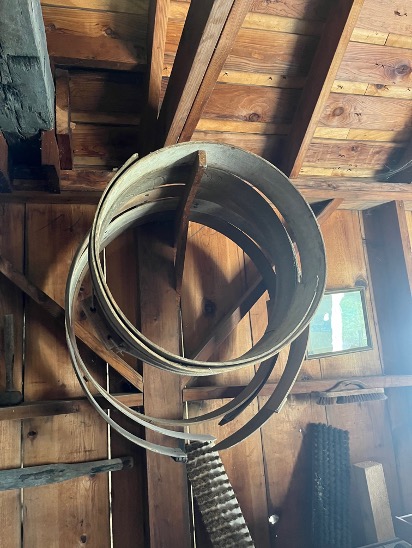This cheese kettle, now held at the Swiss Historical Village in New Glarus, reflects Green County’s cheesemaking past. Made out of copper because of its ability to retain heat well and to be heated easily on an open fire, this cheese kettle symbolizes the increasing importance of cheesemaking in Wisconsin beginning in the 1870s. New Glarus, and Green County more broadly, were major centers of foreign cheesemaking. At one point 91% of the country’s brick cheese, 74% of Swiss cheese, and 48% of the Limburger cheese were made in the state. Although cheese factories evolved rapidly over the decades, early cheesemaking would have taken place in a small kettle like this one.

The first Swiss settlers brought cheesemaking to the state. Although the first few generations of settlers relied on wheat farming, by the 1870s crop failures and an insect infestation soon made growing wheat unprofitable. Thus, the settlers turned to the skills they learned back in Switzerland-dairying and cheesemaking. They also hired specialists to help teach immigrants who didn’t learn these skills in Switzerland. The cheesemaking process at home could be very simple: all that was needed was some milk, a pail, and a wooden hoop to mold the finished cheese. Wives and daughters were the first family cheesemakers, while fathers and sons worked out in the fields. Cheese was made either in the home or in an addition to the house: “a small shed where a copper kettle might be used, with fire boxes of brick or stone, with a crane constructed to swing the kettle on or off the fire”. Cheese was made and consumed at home, and households competed to make the best cheese. Early colonists often made Schab-Zieger, which was very hard to cure and only eaten at home. The cheese is still available today, however it is now known as Green cheese and mainly imported from Switzerland.

In these early days of settlement in the United States, cheesemaking also provided a way for new immigrants to connect with the traditions they left at home. The first group of Swiss settlers to arrive in the United States brought a large number of their belongings with them, thinking that they would be unable to find new items on the frontier or that they would be of a poorer quality than what they were used to in Europe. Along with their clothing and bedding, the immigrants also brought furniture, pots, pans, kettles, and the tools of their trades. Families would likely have brought their cheese kettles as well, making cheese long before the first cheese factories were established. Just like New Glarus was chosen as the site of the colony because of its geographic similarities to Switzerland, early colonists could have used at-home cheesemaking as a reminder of the country they’d left behind to pursue better economic opportunities.
As cheesemaking became more widespread and industrialized, it was done in specialized factories that were mostly owned and operated by men. With increasing national and international recognition of the quality of Swiss cheese, it was important to standardize the process so that all of the exported cheese would be uniformly delicious. This need for standardization also encouraged a trend towards bigger and more industrial cheese factories, and smaller factories found it difficult to keep up. The industry had come a long way from the simple at-home cheese kettles families had once used to make cheese for their families and neighbors, now supplying cheese to consumers all over the country and throughout the world.
Written by Sophia Halverson, April 2023.
SOURCES
Luchsinger, John. The History of a Great Industry. Washington DC: Library of Congress, 1899
Odell, Emery A. Swiss Cheese Industry. Monroe, Wisconsin: Monroe Evening Times, 1936
Trewartha, Glenn Thomas. “The Dairy Industry of Wisconsin as a Geographic Adjustment”, PHD diss (University of Wisconsin, 1924)




